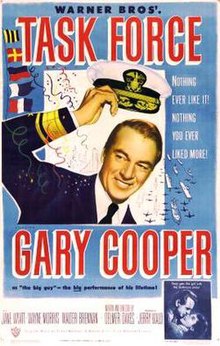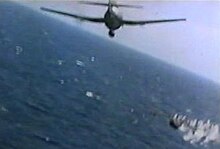Task Force (film)
| Task Force | |
|---|---|

theatrical poster | |
| Directed by | Delmer Daves |
| Produced by | Jerry Wald |
| Written by | Delmer Daves |
| Narrated by | Gary Cooper |
| Starring | Gary Cooper Jane Wyatt |
| Cinematography | Robert Burks Wilfred M. Cline Paul Mantz (Aerial photography) |
| Editing by | Alan Crosland Jr. |
| Studio | Warner Bros. Pictures |
| Distributed by | Warner Bros. Pictures |
| Release dates | 30 August 1949 (premiere) 30 September (NYC) |
| Running time | 116 minutes |
| Country | United States |
| Language | English |
Task Force (1949) is a war film filmed in black-and-white with some Technicolor sequences about the development of U.S. aircraft carriers from the USS Langley (CV-1) to the USS Franklin (CV-13). Although Robert Montgomery was originally considered for the leading role,[1]the film stars Gary Cooper, Jane Wyatt, Walter Brennan, Wayne Morris, Julie London and Jack Holt. Task Force was the only film Gary Cooper and Jane Wyatt made together, and was the last of the eight films Cooper and Walter Brennan made together.[2]The U.S. Navy provided complete support in not only loaning naval vessels and facilities, but also allowed the use of archival footage of the development of naval air power.[3]
Plot[edit]
As a 1917 graduate of the Naval Academy, Naval Aviator Jonathan L. "Scotty" Scott (Gary Cooper) spends 27 years, from 1921 to 1948, promoting naval aviation and the power of the aircraft carrier. During that period, he antagonizes powerful people in the U.S. Navy and Congress, and marries Mary Morgan (Jane Wyatt), the widow of a fellow flier who died in a crash during a carrier takeoff aboard the USS Langley. Throughout, Scott has the help and friendship of his mentor and superior officer, Pete Richard (Walter Brennan).
The Scotts spend two years in Hawaii and then move to Annapolis, where Scott, now a Lieutenant Commander, is to teach naval aviation but his outspoken stand in favor of aircraft carriers in combat causes him to lose a promotion. After Japan invades Manchuria, Scott is offered a civilian sales position selling aircraft in Europe, but remains in the navy.
After Pearl Harbor is attacked by the Japanese, Scott's ship, the USS Enterprise, is heavily involved in action at the Battle of Midway. Scott later travels to Washington to plead for more carriers and eventually a carrier fleet is produced. During the Battle of Okinawa, the fleet, with Scott as the Captain of the carrier USS Franklin, proves its worth. When his carrier flight deck is badly damaged by Japanese torpedo aircraft, the crew is forced to abandon ship. Four years after the end of the war, Scott as an admiral, retires and joins Mary, who is waiting for him on the dock.
Cast[edit]
As appearing in Task Force, (main roles and screen credits identified):[4]
- Gary Cooper as Jonathan L. Scott
- Jane Wyatt as Mary Morgan
- Wayne Morris as McKinney
- Walter Brennan as Pete Richard
- Julie London as Barbara McKinney
- Bruce Bennett as McCluskey
- Jack Holt as Admiral Joseph M. Reeves
- Stanley Ridges as Senator Bentley
- John Ridgely as Dixie Rankin
- Richard Rober as Jack Southern
- Art Baker as Senator Vincent
- Moroni Olsen as Admiral Ames
- Ray Montgomery as Pilot
- Harlan Warde as Timmy Kissell
- Edmond O'Brien as Radio announcer [N 1]
- Louis Bryan Fields as Radio Officer "Lou"

Production[edit]
In 1948, Warner Bros. obtained archival U.S. Navy footage documenting the rise of naval aviation as well as Technicolor footage filmed during the war in the Pacific, including the Battle of Midway, the Japanese attack on USS Yorktown and a kamikaze attack on USS Franklin.[5] Encouraged by the offer of support from the U.S. Navy,[3] when the production received permission to proceed with a film, a decision was made to shot the first segments in black-and-white to merge into the original footage of the USS Langley, the first American aircraft carrier, and the USS Saratoga.[1]Principal photography began in late 1948 on the escort carrier, USS Bairoko (CVE-115) to replicate the USS Langley, as well as Naval Air Station North Island in San Diego.[6] The U.S. Navy provided access to naval facilities with costs amounting to as much as $24,000 a day being incurred when an admiral's barge and jet fighters were commandered.[7] Additional work took place at the Burbank studios to cover interiors and process shots. Production finally wrapped on January 5, 1949.[8]
Near the end of the film, the film changes from black and white to Technicolor in order to unobtrusively use actual combat film shot in color. The change comes just after a scene showing a contentious meeting in Washington D.C. in which Brennan and Cooper argue with a senator who wants to stop building carriers. After some aerial shots of a task force at sea and an aircraft landing on a carrier, still in black-and-white, a shot of a sailor in combat gear silhouetted against the sky is in color, but filtered to make it sepia, a technique similar to that used on the transitional shot of Dorothy opening the door of her house to reveal Munchkinland in The Wizard of Oz. This is followed by Cooper at night walking the deck of his first command, still in sepia, and aircraft taking off at night. The next shot, of a naval task force with air cover, is in full color.[9]
Complications set in during the filming of Task Force as consecutively, four separate crews were at work with the resultant task of merging all of the live action and archival footage. one of the near disasters involved a delivery truck that caught on fire with its load of cut and stock film along with daily rushes, personal baggage and makeup destroyed. More serious was a series of accidents involving the star, who had already expressed reservation both about the script and his perceived inadequacies as an actor.[7] In December 1948, Cooper was on a navy barge that broke down in fog, and began to take on water, almost floundering on the rocks in Long Beach harbor before he was rescued by a navy ship. Cooper was subsequently hospitalized with a high fever.[10] He was nearly seriously injured on another occasion. During gunnery practice, when Cooper was on the USS Antietam, an unmanned target aircraft was hit and caught fire, heading for the crowded deck where all of the actors and crew were standing before skimming overhead, and crashing in the ocean.[7]
Historical accuracy[edit]
During the Battle of Midway scene, the "Japanese carrier" blowing up is actually HMS Barham exploding after being torpedoed by German submarine U-331.
When Cooper and Brennan attend the mid-1920s reception in Washington, D.C., the Chief of Naval Operations is called "Admiral Ames" (Moroni Olsen); the real CNO was Admiral Edward Walter Eberle. The movie CNO is clean shaven, Eberle had a full beard. Seen listening to Scott (Gary Cooper) tell Sen. Bentley (Stanley Ridges) about the use of aircraft carriers over battleships in future naval warfare and that Japan is a threat to the United States, the real Japanese naval attaché who would have heard that conversation was Captain Isoroku Yamamoto. Later, Admiral Yamamoto would be the architect of the attack on Pearl Harbor.
Aircraft used in the film[edit]
Paul Mantz did much of the flying in the early aerial sequences.[11]
- Boeing B-17 Flying Fortress
- Boeing Model 100 standing in for a Curtiss F8C-2 Helldiver
- Curtiss F8C-2 Helldiver
- Curtiss P-36 Hawk standing in for a Mitsubishi A6M Zero
- Douglas SBD Dauntless
- Douglas TBD Devastator
- Grumman F4F Wildcat
- Grumman F6F Hellcat
- Grumman F9F Panther
- Grumman TBM Avenger
- Kawanishi H8K
- Mitsubishi A6M Zero
- Nakajima B6N
- Orenco Model F standing in for a Vought VE-7[6]
- Vought SB2U Vindicator
- Vought VE-7[12]
In popular culture[edit]
In the film, White Heat, when Arthur "Cody" Jarrett played by James Cagney is chased by federal investigators, to lose them, he drives the car into San-Val Drive In, where Task Force is showing. Later in the movie, when Cody's mother is interrogated by the cops, she says that she was with Verna (Virginia Mayo) watching the film and that it was "exciting."[13]
Reception[edit]
Special premieres were screened on the USS Midway at sail in the Atlantic and the USS Valley Forge in the Pacific.[8] When released years after the end of World War II, Task Force was inevitably compared to wartime features and documentaries that chronicled the efforts of the U.S. Navy. Audiences on a whole, received the film enthusiastically, making it one of the "largest grossing pictures" of the postwar era.[8] Critics, although acknowledging the cobbled-up look of the black-and-white photography blending into color, still gave the story positive reviews, keying in on the dramatic aspects. Bosley Crowther of The New York Times noted that when the film concentrates on "real carrier activity out at sea and the actual aspects of recent warfare, it springs into vivid, thrilling life."[14] Playing on the propaganda-like message of Task Force, Radio Moscow decried it, "a film which glorifies war, and calls for the militarization of the country's whole life."[15]
'TV영화관' 카테고리의 다른 글
| The Train (1964 film) (0) | 2014.05.19 |
|---|---|
| Rudyard Kipling (0) | 2014.05.14 |
| The Mating Season (film) (0) | 2014.05.13 |
| Anne of Green Gables (1934 film) (0) | 2014.05.11 |
| Love in the Afternoon (1957 film) (0) | 2014.05.10 |